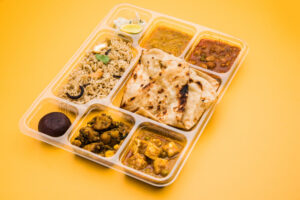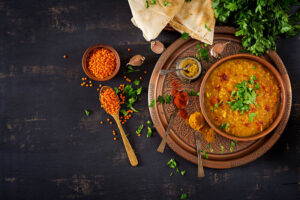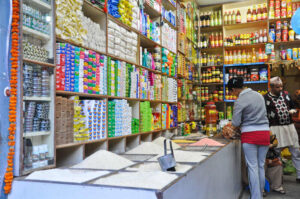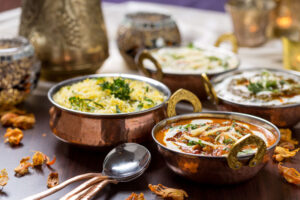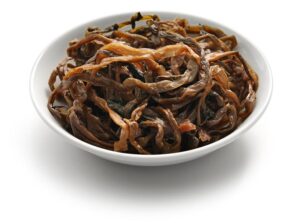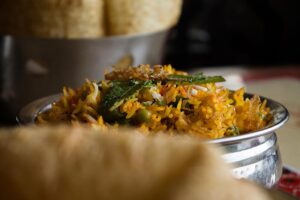Amritsari dal makhani, as the name suggests, comes from the city of Amritsar located in Northern India. Made up of whole black urad dal, this recipe can be prepared easily without compromising on the taste.
That said, this dal makhani is cooked over a slow flame so it might take up longer than your usual evening supper.
If you have got some time on your hands and want to take a deep dive in a creamy bowl filled with the goodness of lentils, then keep on reading to find out more about this Amritsari dal makhani recipe.
About Dal Makhani

Dal makhani is a dish that delivers the rustic taste of Punjab wrapped in lots of creams, lentils, and kidney beans. This dish was originally invented by Kundan Lal Gujral who was an Indian restaurateur.
Amritsari dal makhani (black dal) dish also goes by names such as urad ki dal, mash ki dal, and maa ki dal in India. A highly common recipe in Northern India, Amritsari dal makhani can be served with tandoori roti, Indian rumali roti, naan bread or basmati rice.
Common variations include peshawari dal makhani and dal makhani Oberoi style.
Amritsari dal makhani recipe
Ingredients you will need
- 175g whole black urad dal
- Mustard oil (4tbsp)
- 25g kidney beans (rajma)
- 1 onion
- 2 tomato
- Ginger
- 1 whole bulb garlic
- 1 green chilli
Spices
- 1 bay leaf
- 1 stick cinnamon
- 4 green cardamom
- 4 cloves
- 1 black cardamom
- ½ tbsp garam masala
- 1 tbsp coriander powder
- 100g butter
- 2 tbsp salt
For tempering
- 2 whole red chillies broken
- 40g clarified butter (ghee)
- 2 tbsp kasuri methi/dried fenugreek leaves
- 4 tbsp coriander leaves
Cooking instructions
- Start by soaking the lentils and rajma overnight in a bowl filled with filtered lukewarm water. This will cause the lentils and kidney beans to become. In case you forget to soak them or are short on time, you can put the beans in hot water for ten minutes.
- Now rinse all the water out and set your lentils and kidney beans aside. In a pressure cooker, add 4 tablespoon mustard oil followed by adding whole black lentils and kidney beans. Make sure to add enough water so that it is at least 3-4 inches above the dal.
- Next up, remove the onion skin and chop it along with 2 tomatoes, green chilli and garlic (skin removed). Blend this mixture so that it forms a smooth paste and add 50ml water to it to balance the consistency with your dal in case it comes out too thick.
- Now add this paste to the pressure cooker and cook it for 45 minutes by the clock. Once the 45 minutes have passed, dial down the pressure and transfer the mixture to a heavy bottom pan.
Note: A pan with a thick bottom is highly imperative since you will be cooking this dal for 3-4 hours.
- Now add green cardamoms, 1 black cardamom, 4 cloves, 1 bay leaf and an inch long cinnamon stick to the dal in the pan. Add some water if the mixture appears to be too thick.
- Then, cook the dal for an hour while mashing and whisking it using a hand masher or a flat based spatula. Once the dal has been cooked for an hour, add 100 grams of butter to it and mix well.
- Stirring the dal regularly will ensure that the spices do not stick to the bottom. Another possible reason behind this happening is lack of water, so be sure to add enough.
- Once the consistency of your dal reaches a medium-thick level, add some salt, garam masala, a tablespoon of coriander powder and red chili powder (optional).
Tip: The secret to a delicious dal makhani is the duration you cook it for. This is because cooking for a longer time helps the spices and butter dissolve into the gravy, thus giving it a thick texture and creamy taste.
Here’s a video that might help.
- Now that your dal is almost ready, start preparing the tempering alongside. Heat clarified butter/ghee in a pan and once it becomes hot add two whole dry red chillies. You will see that the chillies change color after 2-3 minutes. This is the point where you should add dried fenugreek leaves and coriander leaves into the mixture.
- Pour the tempering on your dal while it’s still hot.
- Your Amritsari dal makhani is now ready. You can serve it with freshly prepared nan bread or tandoori rotis.
Note: It is also believed that the taste of dal makhani gets better if you refrigerate it and eat it the next day. This recipe stays fresh for 12-36 hours after preparation.
Can we make dal makhani with split urad dal?

Yes, you can! Just like lentils, you can soak the split urad dal overnight and carry out the same steps that we discussed above. Furthermore, split urad dal can also be used to make traditional Indian black gram dal, which is known for its spicy aftertaste.
Another point to note here is that since split urad dal retains the skin, it has a strong flavor giving your dal a somewhat bland taste, which may not be liked by some. It is due to this reason that whole black lentils are prefered over split urad dal.
Want to make dal makhani even healthier? Try dal makhani kerala style.
Mistakes to avoid when making dal
Even though this recipe doesn’t involve any complicated technique, there are some mistakes you may want to look out for.
- The first is using tap water. Tap water is good but in certain areas, the water supply delivers hard water which prevents the lentils from cooking properly. As you cook the lentils, they are supposed to become softer. Instead, you should go for filtered water for better results.
- The time you soak your beans and lentils also plays an important role in the final texture. Given below are soaking times of some of the most common lentils :
| Masoor dal (red/brown lentils) | 30 minutes to an hour |
| Toor dal (split pigeon peas) | 2 hours |
| Urad dal (white lentils) | 2 hours |
| Moong dal (yellow when split) | 30 minutes to an hour |
- Once you keep your dal on a boiling vessel, you will notice scum formatting on the edges after a few minutes. Keep in mind to remove the scum using a spatula so that your dal makhani does not end up tasting bitter and odd.
- When picking out lentils from an online store or supermarket, be mindful of their age. If the lentils are too old, they do not get soft easily making it extremely hard to cook them.
- Carefully balance the amount of salt to put into your dal makhani as this ingredient is what can make or break your recipe. As a general rule of thumb, you can use 0.5-1 tbsp of salt per cup of dal you cook. In case your dal tastes bitter, another culprit could be mint or the spinach you add in your tadka.
I hope that you liked this Amritsari dal makhani recipe. Happy cooking!

